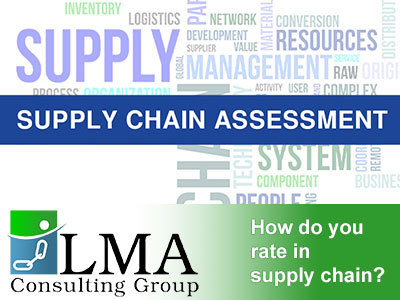Clients typically set goals; however, goals without an understanding of where you stand is non-value added. Although it is common to set goals and expect employees to achieve them, it is far less common for clients to understand how they will get from the current state to the desired future state. You must start by understanding where you stand in your supply chain. Unfortunately, although this sounds obvious (and Executives would agree), in reality, it is uncommon common sense!
How comfortable are you that you understand where you stand when it comes to your supply chain? We thought it would be of value to create a quick (2 minute) supply chain assessment quiz so that you can self-assess your supply chain. Learn more about the quiz here.
Client Example: Supply Chain Assessment for Service Turnaround
Our first step of any project is to perform a rapid supply chain assessment. For LMA to help a client, we must know the current situation. We do a review of people, processes, systems (ERP and peripheral systems such as CRM, CPQ, etc.), data, alignment with strategy, etc. Since we are focused on bottom line results, we must determine how to get from “here” to “there” on the quickest and smartest path while ensuring quick wins and value along the way.
For example, an aerospace manufacturer wanted to improve delivery performance to support key customer programs (Boeing, Gulfstream, etc.). In essence, they wanted to dramatically increase OTIF (on-time-in-full) from the mid 60%’s rapidly and reduce lead times to a more acceptable and attractive level for customers while maintaining or improving costs and working capital levels. The executives brought us in as supply chain consultants to upgrade their systems, processes, and talent to achieve these goals.
Our first priority was to perform a supply chain assessment. We reviewed their end-to-end order flow process, use of ERP, data, and skills/ talent. This provided us with a good understanding of their strengths, weaknesses, opportunities, and risks of execution so that we could put together a roadmap for success.
We stuck around and partnered with our client to roll out demand planning, master scheduling, capacity planning, and SIOP (Sales Inventory Operations Planning), also known as S&OP programs. Based on the assessment, we knew we could better utilize their ERP system and upgrade processes by entering forecasts, analyzing capacity plans and establishing supplier contracts with attractive pricing and stability. Additionally, we identified training and education opportunities and risks of execution so that we could mitigate potential bottlenecks. We brought service levels into the 90%’s, gained key customer confidence with improved scorecard performance, and improved margins by several points by rolling out materials forecasts, supplier contracts, and by gaining long-term visibility into operational capacity to minimize costs.
Client Example: Supply Chain Assessment to Turnaround an ERP Debacle
In an electrical equipment manufacturer, customers were upset due to lagging service levels and key employees were overwhelmed with an insurmountable workload following the launch of a new ERP system. After jumping into the details to work with their North American planners to unbury the schedule and to develop directional capacity information, we performed a supply chain assessment with an eye to use of ERP. There was no way to find a grain of sand in the ocean of details without assessing their supply chain and use of ERP.
Although we have a combined 99+ years of experience, 112+ successful client engagements with bottom line business results, 42+ ERP projects, and specialized manufacturing experience, jumping into the process and working with the key resources to turn around the execution didn’t provide enough information to put together a long-term path forward that would achieve the radical improvement required with the ERP system. Thus, an assessment was required with the full scope of ERP as it relates to supply chain and order creation and fulfillment.
We spent five weeks in an around-the-clock focused effort as the situation was urgent to gain a thorough perspective of the business processes, use of ERP and associated skills. After all, our team had to absorb what the ERP implementation team took a year to develop and roll out while understanding the impacts on the supply chain teams (demand planning, production planning, materials planning, capacity planning, etc.) and the correlation to the business bottlenecks. We reviewed business requirements, ERP functionality, offline spreadsheet processes, the status of data integrity, data availability, the status of training and development, availability of key resources, etc. Although it was a hair-raising process, we were successful in putting together an assessment, resource recommendations, quick wins and long-term solution to rectify the use of the ERP system to drive the business results.
The Bottom Line
Take a step back and assess what is needed to achieve your objectives. Don’t “stay in your lane” if you require a broader scope to ensure results even if you must have uncomfortable conversations and take risks in pushing back on standard assumptions. On the other hand, don’t fall into analysis paralysis. When you have a directional view that is assured to get you moving in the “right” direction (even if not 100% optimal), start moving. Avoid circular discussions and pivot back to the key points.
Also consider the people, the process, the system, the data, metrics and strategy in conjunction with each other. Focusing on technical without the process and people will not work, but focusing on the people without a good understanding of the technical and process aspects will not work either. In fact, you will come to inaccurate conclusions in your assessment that will make the situation worse, not better. Instead, use uncommon common sense, and you success rate will skyrocket.
If you are interested in reading more on this topic:
Why Planning is Impacted as Disruptions Abound



